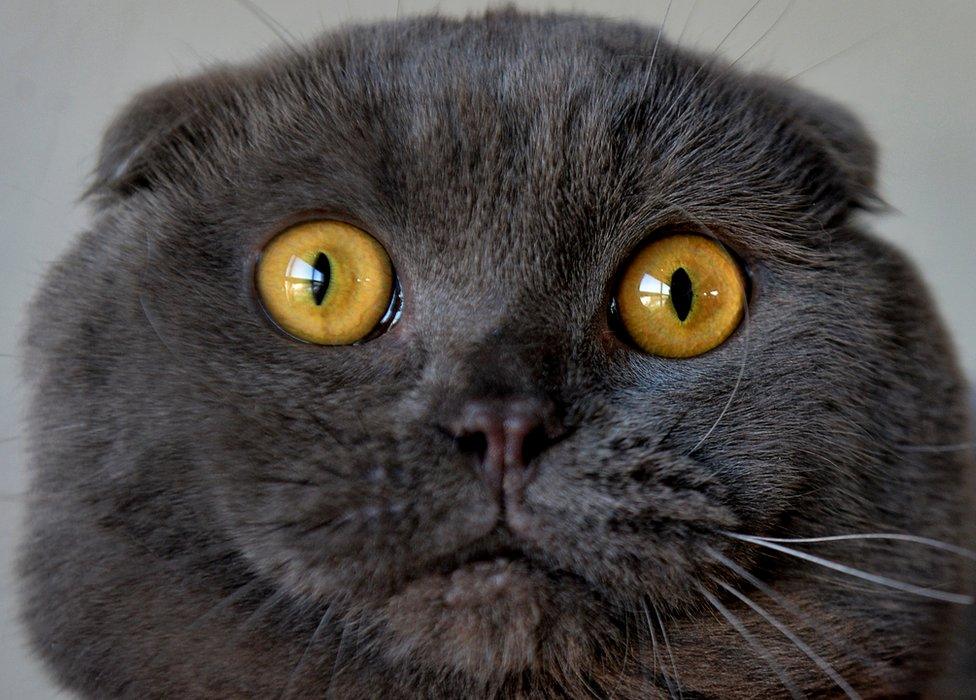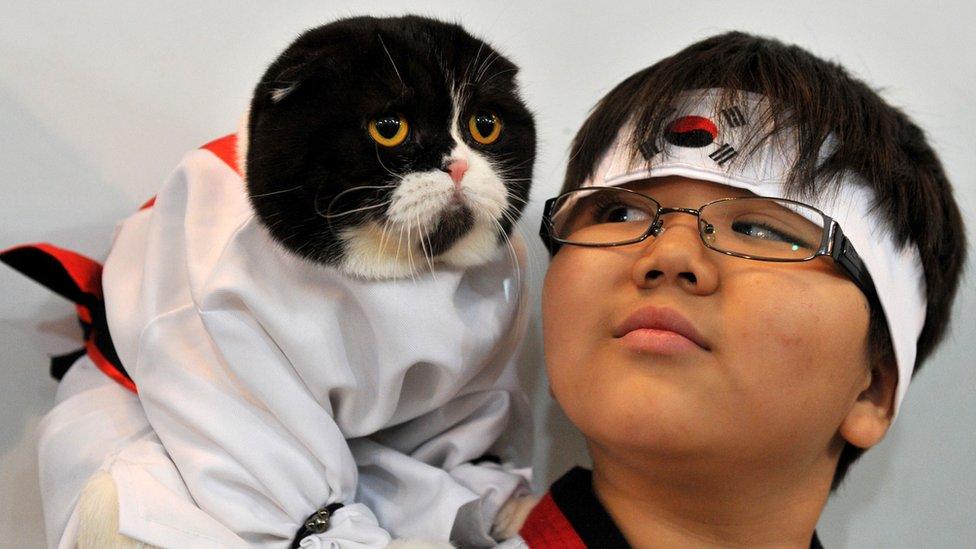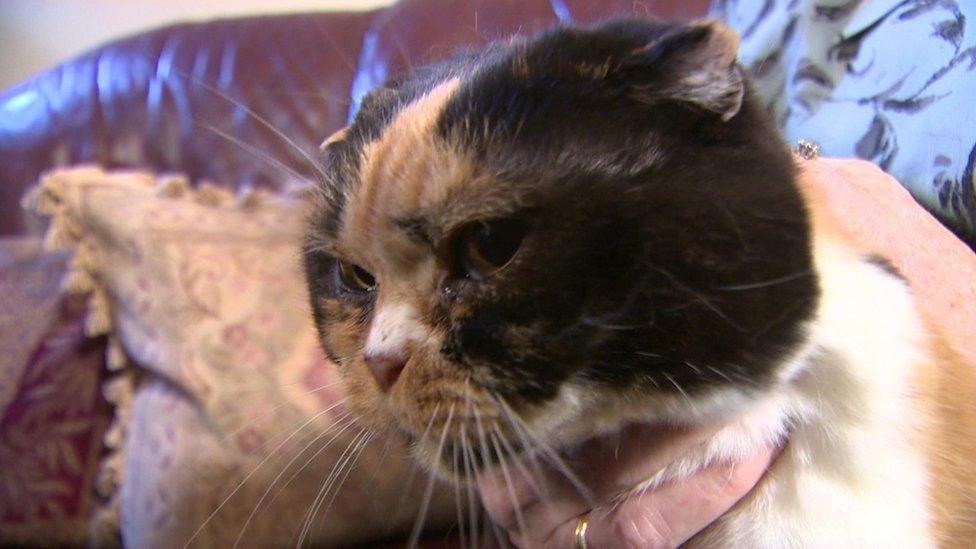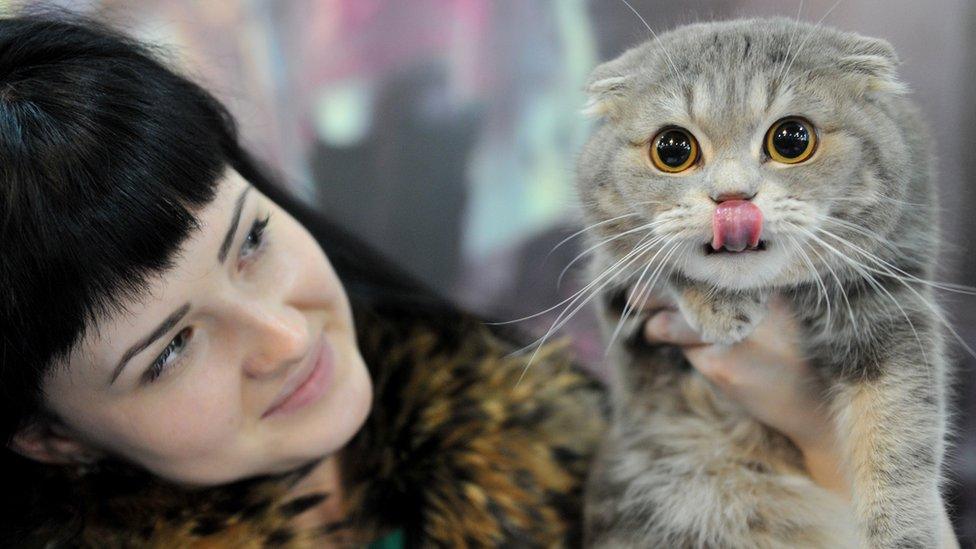Should Scottish fold cats be banned?
- Published
- comments
The British Veterinary Association says the breeding of Scottish Fold cats should be banned
The British Veterinary Association has warned breeding of Scottish fold cats should stop because of health fears.
The breed has had a surge of popularity after celebrity owners such as Taylor Swift and Ed Sheeran posted photos on Instagram.
The cats, which originated in Scotland in the 1960s, are famous for their small floppy ears.
However, this is the result of a genetic condition that can cause them to have short and painful lives.

Celebrities such as Ed Sheeran and Taylor Swift own Scottish fold cats
One of the most famous cats on the internet is a Scottish fold who lives in Japan called Maru, whose videos have been watched more than 300 million times on Youtube.
The breed is popular because it is "cute", says Gudrun Ravetz, the president of the British Veterinary Association.
She told BBC Scotland: "These cats have become so popular on social media and with celebrities.

A Scottish fold cat is pictured during a cat exhibition in Kyrgyzstan
"People are wanting to have these cats because of that, but unfortunately it is another example of us prioritising how a pet looks rather than their quality of life."
She says the cats have a genetic mutation that affects their cartilage which leads to the folding of the ears and an owl-like appearance.
"The cartilage is deformed and it is not supporting the ears," Ms Ravetz says.
She says the cartilage mutation also leads to problems with other parts of the cat's body.
"These genetic mutations, which all the Scottish fold cats will have, develop into lifelong incurable and painful diseases such as a type of arthritis."

What is the Scottish fold cat?

Wearing a hat and glasses, a Scottish fold cat looks on during a cat exhibition in Bishkek
All Scottish folds are descended from a white barn cat named Susie who was discovered living on a farm near Coupar Angus in 1961.
She caught the eye of a local shepherd and cat fancier, William Ross, who noted that her ears folded forward.
The Rosses started a breeding programme and in 1966 began registering their cats with the Governing Council of the Cat Fancy, the UK's pedigree cat registry.
However, in the early 1970s, the GCCF stopped registering folds because of concerns about ear disorders and hearing problems.
The breed's popularity in the UK fell after this but the United States soon took the cats to its heart.
They were first introduced to the US in 1970 when three kittens from one of Susie's descendents were sent to a research centre in Massachusetts for a study of their mutations.
When the research was abandoned, the cats were re-homed.
One of the cats found his way to Salle Wolfe Peters in Pennsylvania, who is thought to be chiefly responsible for developing the breed in the United States.
The breed is still popular in the US and has been exported around the world.

Health problems

A boy and his Scottish fold cat dressed in a hanbok costume attend a cat exhibition
The GCCF said it had maintained its ban on the breed since the 1970s on health grounds.
Rosemary Fisher, from the GCCF, said: "They are cute but then you realise the health problems they have.
"We don't register them or even allow them to be exhibited or put in our shows."
However, the breed can be registered with other organisations in Britain and around the world.
You might also like:
Some advocates for the breed say that responsible breeders never mate one Scottish fold to another, instead combining them with an American Shorthair or British Shorthair.
They claim that this leads to less possibility of congenital health problems.
"No. That's not the case," says Ms Ravetz from the British Veterinary Association.
"All cats with this folded ear appearance will have the genetic mutation.
"The rate at which they get the disease and the severity of the disease can be different but they will all to some degree have an incurable, painful and lifelong disease. We should not be breeding pets that can have these problems."

Vets say people should not be prioritising looks over health
Dee has been breeding Scottish Folds for 10 years, even providing pop star Ed Sheeran with his beloved cats.
She says: "If I had discovered there had been a significant problem I would certainly have stopped breeding them.
"But when you balance that against the number of health issues that occur in other breeds, you could argue that for most pedigree breeds."
The British Veterinary Association said that, unlike dogs, most cats do not have any pedigree.
They said about 80% of cats were just plain "moggies" but they were worried that social media was driving a fashion for designer cats who were bred for appearance rather than health.

The Scottish fold cat originated in Scotland but has become popular around the world
Ms Ravetz said: "There is no excuse for breeding from an animal who we know is going to suffer a painful and lifelong incurable disease.
"There are plenty of lovely moggies out there in rescue homes looking for a forever home that would make lovely pets for people."
She added: "This desire to have something based on looks rather than quality of life is across many of the pets we are getting and that's being fuelled by social media.
"There is also a rise in what we call brachycephalic dog breeds - the pugs, the English bulldogs, the French bulldogs - that can have a range of problems including debilitating breathing problems. This is because we are prioritising how they look."
Veterinary industry journal Vet Record is banning advertisements which use flat-faced dogs.
It has now said it will be reviewing the use of the Scottish fold cat.
Vet Record editor Adele Waters said: "There is really something wrong in the way that we as a society believe that it is right to breed animals for their looks.
"It is perhaps something that we should question."
There is currently no breeding ban on the Scottish fold cat or restrictions on cat breeding in the UK but the Scottish government said it was considering introducing a ban on the breed.
It added: "The Scottish government would encourage anyone breeding any type of animal to avoid breeding from any individual animals with genetic problems likely to give rise to ill health."